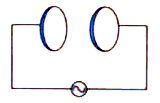Which physical quantity is the same for microwaves of wavelength 1 mm and UV radiations of 1600 A° in vacuum?
To determine which physical quantity is the same for microwaves of wavelength 1 mm and UV radiations of 1600 Å in vacuum, we can follow these steps:
Step 1: Identify the Wavelengths
- The wavelength of microwaves is given as 1 mm.
- The wavelength of UV radiation is given as 1600 Å (1 Å = 10^-10 m, so 1600 Å = 1600 x 10^-10 m = 1.6 x 10^-7 m).
Step 2: Understand the Nature of Electromagnetic Waves
- Both microwaves and UV radiation are types of electromagnetic (EM) waves.
- EM waves travel through vacuum at a constant speed, regardless of their wavelength or frequency.
Step 3: Recall the Speed of Light
- The speed of light in vacuum is a universal constant denoted by 'c'.
- The value of 'c' is approximately 3 x 10^8 meters per second (m/s).
Step 4: Conclusion
- Since both types of radiation (microwaves and UV) are electromagnetic waves, they both travel at the same speed in vacuum, which is the speed of light (c).
- Therefore, the physical quantity that is the same for both microwaves of wavelength 1 mm and UV radiation of 1600 Å in vacuum is the speed of light.
Final Answer
The physical quantity that is the same for microwaves of wavelength 1 mm and UV radiations of 1600 Å in vacuum is the speed of light.
---
- The wavelength of microwaves is given as 1 mm.
- The wavelength of UV radiation is given as 1600 Å (1 Å = 10^-10 m, so 1600 Å = 1600 x 10^-10 m = 1.6 x 10^-7 m).
- Both microwaves and UV radiation are types of electromagnetic (EM) waves.
- EM waves travel through vacuum at a constant speed, regardless of their wavelength or frequency.
- The speed of light in vacuum is a universal constant denoted by 'c'.
- The value of 'c' is approximately 3 x 10^8 meters per second (m/s).
- Since both types of radiation (microwaves and UV) are electromagnetic waves, they both travel at the same speed in vacuum, which is the speed of light (c).
- Therefore, the physical quantity that is the same for both microwaves of wavelength 1 mm and UV radiation of 1600 Å in vacuum is the speed of light.
The physical quantity that is the same for microwaves of wavelength 1 mm and UV radiations of 1600 Å in vacuum is the speed of light.
Topper's Solved these Questions
- ELECTROMAGNETIC WAVES AND OPTICSBOOK - CBSE COMPLEMENTARY MATERIALCHAPTER - ELECTROMAGNETIC WAVES AND OPTICSEXERCISE - SHORT ANSWER QUESTION 1 MARK
5 Videos
- ELECTROMAGNETIC WAVES AND OPTICSBOOK - CBSE COMPLEMENTARY MATERIALCHAPTER - ELECTROMAGNETIC WAVES AND OPTICSEXERCISE - SHORT ANSWER QUESTION 2 MARKS
37 Videos
- DUAL NATURE OF MATTER AND RADIATION & ATOMS AND NUCLEIBOOK - CBSE COMPLEMENTARY MATERIALCHAPTER - DUAL NATURE OF MATTER AND RADIATION & ATOMS AND NUCLEIEXERCISE - Long Answer Question
22 Videos
- ELECTRONIC DEVICES BOOK - CBSE COMPLEMENTARY MATERIALCHAPTER - ELECTRONIC DEVICES EXERCISE - NUMERICALS
7 Videos
Similar Questions
Knowledge Check
Which physical quantities have the same dimension
ACouple of force and workBForce and powerCLatent heat and specific heatDWork and powerWhich physical quantities have same dimensions ?
AForce and powerBTorque and energyCTorque and powerDForce and TorqueWhich physical quantities have the same dimension?
ACouple and WorkBWork and PowerCForce and PowerDLatent Heat and Specific Heat
Which physical quantity unit is same in all systems
View SolutionWhat physical quantity is the same for X- rays of wavelength 1010m,red light of wavelength 6800A and radio waves of wavelength 500m ?
View SolutionWhat physical quantity is the same for X - rays of wavelength 10−10m, red light of wavelength 6800Å and radiowaves of wavelength 500m?

View SolutionWhich physical quantity have the same unit as that of impulse ?
View SolutionThe physical quantities not having same dimensions are
View Solution
